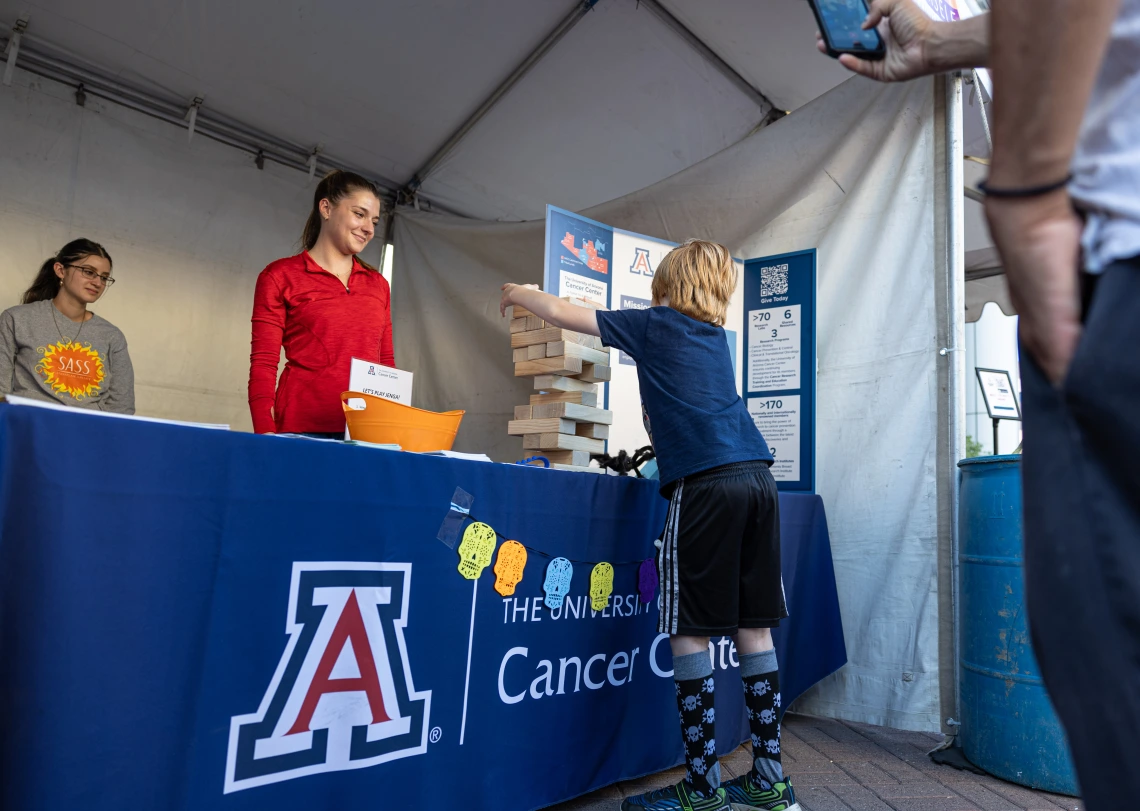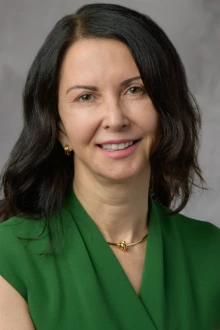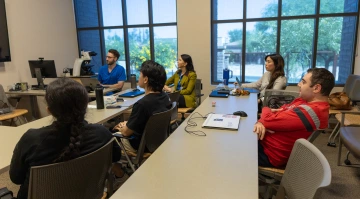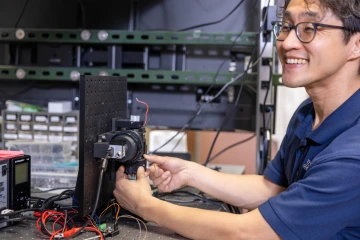Harmonizing with the sun: UACC’s Skin Cancer Institute helps keep Arizona safe through prevention, early detection, treatment

Living in the state with the second highest UV index––a measure of the strength of ultraviolet (UV) radiation from the sun––people in Arizona are affected by the Earth’s closest star daily.
For Clara Curiel-Lewandrowski, MD, co-director of the University of Arizona Skin Cancer Institute, the connection between sun exposure and skin cancer is alarming.
“We know that the association between sun rays or ultraviolet exposure, particularly for indoor tanning, is stronger with skin cancer than smoking is related to lung cancer,” said Curiel-Lewandrowski. “Despite this strong evidence and continued effort to educate the community about the harmful effect of excessive sun exposure, we still diagnose an excessive number of skin cancers every year. We have a long way to go.”
According to Curiel-Lewandrowski, many people come to Arizona specifically for its 300-plus days of sunny weather. It is for them that the professor and chief of the Division of Dermatology at the University of Arizona College of Medicine – Tucson has dedicated her career to building a leading research institute, which teaches the community how to live in harmony with the sun.

Clara Curiel-Lewandrowski, MD
“The UACC Skin Cancer Institute is special,” Curiel-Lewandrowski said. “If you look across the country, even worldwide, there are very few places like what we have here with SCI. We focus on prevention we focus on early detection, and we focus on treatment. We’ve got a 360-degree, powerful approach to fighting skin cancer.”
Curiel-Lewandrowski has been interested in the effects of skin cancer for most of her medical career. Her passion was fueled early on by having close relatives affected by metastatic melanoma and listening to her patient’s diagnosed with skin cancer regretting their frequent and excessive exposure to sun rays early on in their lives.
“It was through listening to my patients and understanding their stories and their regrets that inspired me to focus a large component of my research efforts on identifying novel approaches in prevention and the early detection aspect of skin cancer,” she said.
Focusing on the skin health of Arizonans
Both Curiel-Lewandrowski and SCI co-director Robin Harris, PhD, Department of Epidemiology and Biostatistics at the Mel and Enid Zuckerman College of Public Health, were part of the SCI founding membership with the late David Alberts, MD, former director of the UArizona Cancer Center. Through the assistance of Tucson philanthropists concerned about skin cancer, the researchers brought together faculty from throughout the Cancer Center and built an institute with four pillars––outreach, research, patient care and prevention.
Harris said her research initially focused on the incidence of various skin cancers and the factors for their development.
“[Through the years,] It became less about my research but more of our vision to build the SCI educational components, the outreach components and evaluations,” she said.
Harris said that due to budget constraints, SCI started training University of Arizona students to become community ambassadors through a for-credit service-learning course at the College of Public Health. The community ambassadors travel to schools and educate young students about the effects of the sun, the importance of using sunscreen, covering up, and avoiding the sun during peak hours.
“Since 2007, we've trained more than 400 university students at different locations, and they have reached about 1,500 schoolchildren each year,” Harris said. “There are ambassadors and multiple events that we’re responsible for throughout southern Arizona.”
Teaching prevention
Curiel-Lewandrowski said that starting in elementary school, students should be properly and consistently educated on of the importance of primary prevention of skin cancer.
"It needs to become part of how we think and act as we are exposed on daily basis to significant UV radiation while outdoors in our state," she said.
For UV exposure, both acute, which is the sunburn type, and chronic, which occurs over years, are linked to skin cancer.
"Some research studies suggest an increased association between melanoma and acute exposure, while a chronic pattern is preferentially associated with the non-melanoma type of skin cancer," Curiel-Lewandrowski said. "Either way, the evidence is clear: the more sun exposure you have, the greater the chance of developing skin cancer.”
She said it is important that SCI educates everyone about skin cancer, including individuals with a darker skin type, since certain skin cancers can affect this group preferentially, such as for acral melanoma.
"Everyone in our community, young, seniors, those with light skin, and those with darker skin, should be aware of the importance of skin cancer prevention and early detection," she said.
What are the types of skin cancer?

A group of graduate students examine a case study in the Banner – University Medicine Multispecialty Services Clinic.
Curiel-Lewandrowski said that skin cancer is one of the most common types of cancers, with 1 in 5 caucasian patients affected with this diagnosis, and more than 5 million cases diagnosed every year in the United States alone.
There are two main skin cancer types, melanoma and non-melanoma.
“Non-melanoma skin cancers that typically originate from keratinocytes and melanoma which arise from melanocytes, the cells responsible for skin pigmentation. Within the non-melanoma skin cancer category, the most common type is basal cell carcinoma, and the second one is squamous cell carcinoma,” she said. “They come from completely different cell types. Melanoma comes from melanocytes and squamous cell carcinomas and basal cell carcinomas come from keratinocytes. Most individuals will be affected with non-melanoma skin cancers.”
She said that more than 5.4 million people are diagnosed with non-melanoma skin cancer in the U.S. while almost 100,000 individuals are diagnosed with melanoma every year in the U.S.
Collaborating on skin-saving solutions
“One of the unique aspects of this Skin Cancer Institute, is the established research and educational collaborations with other members across the university, across the state, across the U.S. and also internationally,” Curiel-Lewandrowski said. “We constantly seek an opportunity to expand our collaboration network, which benefits everyone, especially young investigators who need a support system to maximize the chance to succeed in a highly competitive environment.”
Harris said one of SCI projects she is most proud of is their creation of the Melanoma Task Force in 2012 to assess the degree of under-reporting of melanoma to the Arizona Cancer Registry, identify barriers to reporting by providers, and recommend strategies for increasing reporting.
SCI also developed the Patient Registry Imaging Database and Tissue Bank, or PRIT, created in collaboration with data scientists at UArizona Health Sciences. The registry stores and organizes clinical, biological and tumor imaging data in three different databases that are interconnected at the individual lesions level. This system represents a robust library of skin cancer data for researchers to access and understand factors associated with skin cancer development (carcinogenesis), early diagnosis, prognosis, and determinants of tumor response to treatment.

D.K. Kang, PhD, works on a portable confocal microscope in his optical lab.
Curiel-Lewandrowski said another impactful project was the creation of a portable, noninvasive skin cancer diagnostic microscope using reflectance confocal microscopy (RCM), a project led by Dongkyun Kang, PhD, associate professor in the Department of Optical Sciences and Biomedical Engineering in the UArizona College of Optical Sciences.
“The RCM is best described as a live microscope that can be placed on the surface of the skin and allows you to visualize the layers of the skin up to 300 microns without doing an invasive procedure,” Curiel-Lewandrowski said.
To assist patients, SCI offers them clinical trials. Patients who have skin cancer can participate in cooperative, sponsored and investigator initiated trials.
“We bring them here [trials] to be able to offer our patients the best chance to either prevent, diagnose early, or treat skin cancers,” she said.
They also offer Cancer Center member investigator-initiated trials.
”The investigator-initiated clinical trials are critical to drive the science in the areas we identify as clinical gaps. We need to think out of the box,” she said. "Current exponential growth in skin cancer cases further necessitates the identification of innovative and effective solutions."
One example is a study by researchers from the University of Arizona and Texas Oncology who found that a cancer drug used for melanoma called talimogene laherparepvec (TVEC) is effective for patients with invasive squamous cell carcinoma (cSCC).
“The interesting aspect of this trial that was recently presented at American Association of Cancer Research, and soon to be published, is the capacity to not only effectively treat the tumor with 100% response rate, but also the possibility of preventing additional new tumors over the following two years,” she said.
One of the research programs that has been a force of innovation at the Skin Cancer Institute for the past two decades is the Chemoprevention of Skin Cancer Program Project Grant funded by the National Cancer Institute in the Division of Cancer Prevention.
The objective of this team science grant now led by Curiel-Lewandrowski and Cancer Center member Georg Wondrak, PhD, professor in the University of Arizona Department of Pharmacology and Toxicology in the R. Ken Coit College of Pharmacy, is to identify key biomarkers in skin cells that can be targeted with different agents, mostly small molecule topical agents, to be able to prevent the development of skin cancers, in particular squamous cell carcinoma.
“Through our current research, we hope to enhance the immune system locally and allow proper recognition of atypical cells to be eliminated early on in the carcinogenesis process with minimal toxicity for the patients,” she said. “We are uniquely positioned to address this challenge because of our collective expertise and capacity to execute and drive projects to the finish line, and into the next frontier.”
Curiel-Lewandrowski said that she is grateful to work in a collaborative, multidisciplinary environment where everyone is focused on the mission to fight skin cancer with a 360 approach for all patients throughout Arizona and beyond.
“This cannot happen in a vacuum,” she said. “It is a team effort with interdisciplinary members from the Cancer Center, College of Medicine, College of Pharmacy, Bio5 Institute, College of Public Health, College of Engineering, College of Nursing, the Data Science Institute, and several others. We all come together to identify the solutions.”



